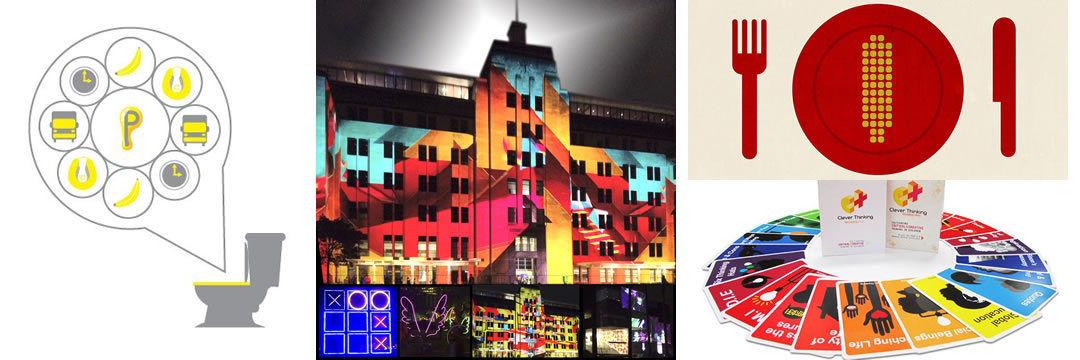
Graphic Design
Responsible Visual Communication
- Strive to create the greatest visual impact with the least environmental impact
Achieving clients needs while limiting potential ecological damage - Consider the use of Recycled paper stock with a high Post Consumer (PC) recycled fibre content
Clean mill waste has always been recycled so it is better to keep consumer paper out of landfill - Consider the use of tree free paper stock such as sugar cane waste, straw, seaweed, algae and hemp
Alternative renewable paper sources can reduce need for wood pulp from old growth forests
- Consider the use of vegetable based printing inks such as soy inks
Vegetable based inks are renewable and emit less toxic Volatile Organic Compounds (VOCs) - Avoid the use of ink colours which contain high levels of heavy metals such as copper, chrome, etc.
Many bright colours contain heavy metals which leach into ground water when landfilled - Ensure the use of unbleached or non chlorine bleached paper stock
Bleached paper requires the use of toxins which are harmful to marine and water based life
• Interesting rebrand – on many levels… Asian carp rebranded as ‘Copi’ to help in tackling US environmental crisis. On behalf of the US government, Span studio has created the new branding for the invasive fish species. DesignWeek story by Abbey Bamford: designweek.co.uk/issues/27-june/asian-carp-rebrand Good to see forward thinking in plan and action. #BeResponsible #ThinkResponsible #ResponsibleDesign #wildcaught ChooseCopi.com
Circular economy, upstream innovation is about tracing a problem back to its root cause and tackling it there. Rather than working out how to deal with a pile of waste, prevent it from being created in the first place using three innovation strategies – elimination, reuse and material circulation. See how moving upstream can stop packaging waste and pollution while generating economic benefits plastics.emf.org/upstream from Ellen MacArthur Foundation. Lots of case studies, downloads, guides & resources.
- Encourage their clients to consider the environmental impact of their production
Educated clients are more willing to undertake ecologically sound projects - Avoid overuse of gloss paper stock, because more exists than can be de-inked and recycled
In some areas there is a glut of gloss paper because satin or matt paper is used less - Avoid overuse of plastic films, foil stampings, metallic colours and synthetic adhesives
Some synthetics have a life of 200-500 years after they have been disposed of in landfills
- Consider the smallest paper size suitable for each job, ie A5 instead of A4
Less paper used means less energy expended and should also be cheaper for client - Avoid ‘bleeds’ that are then trimmed and must be de-inked before recycling
- Ink extended beyond trim marks requires more intensive recycling than ink within trim marks
- Avoid over use of perfect bound or spiral bound spines as they are difficult to recycle
The glues and metals in such binding impede cost effective recycling
- Encourage their clients to consider the environmental impact of their production
Educated clients are more willing to undertake ecologically sound projects - Avoid overuse of gloss paper stock, because more exists than can be de-inked and recycled
In some areas there is a glut of gloss paper because satin or matt paper is used less - Avoid overuse of plastic films, foil stampings, metallic colours and synthetic adhesives
Some synthetics have a life of 200-500 years after they have been disposed of in landfills
- Consider the smallest paper size suitable for each job, ie A5 instead of A4
Less paper used means less energy expended and should also be cheaper for client - Avoid ‘bleeds’ that are then trimmed and must be de-inked before recycling
- Ink extended beyond trim marks requires more intensive recycling than ink within trim marks
- Avoid over use of perfect bound or spiral bound spines as they are difficult to recycle
The glues and metals in such binding impede cost effective recycling
- Consider using filmless and plateless digital printing technology for small run jobs
Modern printing technology can reduce amount of plastics, metals and inks used for printing - Use paper sizes and number of pages that best fit standard sheet stocks without wasteful trimming
Printers can advise on best use of sheet stock for less paper wastage and more price savings - Avoid using too much ink in their designs
More ink means more difficult de-inking or greater toxic residue leaching into groundwater - SRD will soon be publishing its updated Recommended Environmentally Accountable Paper guide
- Use the appropriate recycled logo or stewardship logos to promote the nature of their production
Customers and Users need the opportunity to know the ethical qualitiy of the goods they are purchasing - Promote design responsibility by printing PCW content, ink and bleaching type on their work
Customers & Users educated by one product will look for the same credentials in other other products - Keep informed of the latest environmental developments in inks, papers and printing processes
New technologies and rediscoveries of old techniques for green design are occurring constantly - We welcome input from all related Visual fields to improve our data.
The Tropical Forest Alliance 2020 (TFA 2020) brings together governments, the private-sector and civil society organizations to work together to remove deforestation linked to the production of commodities such as palm oil, beef, soy, and pulp and paper… https://www.weforum.org/our-impact/stopping-commodity-related-deforestation NEW YORK DECLARATION ON FORESTS PROGRESS ASSESSMENT Goal 2: Support and help meet the private-sector goal of eliminating deforestation… http://forestdeclaration.org/goal/goal-2/










